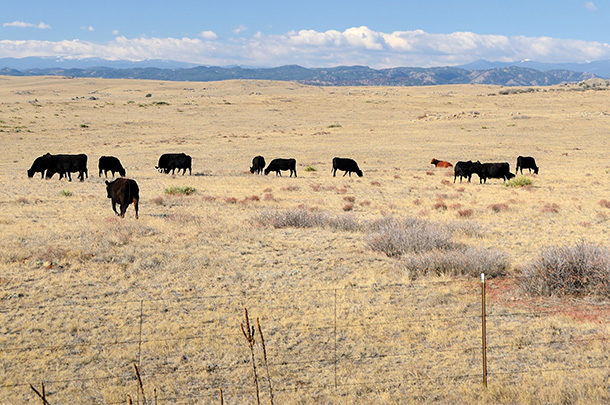As we head into the middle of summer, taking stock of pasture and forage status for the rest of the growing season is a good practice to implement, especially when faced with dry weather. Not everyone reading this may be facing drought, and that’s great.
However, while drought may not be a concern this year, for most producers in the U.S. drought is a common occurrence that is part of the natural cycle of management of cattle on grazing lands. Being prepared for that day can save on stress, time and money.
By midsummer, cool-season plants will be hitting their summer slump, slowing growth as temperatures rise and they become less efficient photosynthesizing. Once this growth has peaked, we will have a good idea how much production they will provide until temperatures cool in the fall. In contrast, warm-season pastures are in the middle of their rapid growth phase. This makes guessing their end-of-year production a bit tricky. If we have a pasture monitoring program in place, though, we can make an educated estimate.
During these key evaluation periods, pasture monitoring programs really shine. Even a simple photo-point taken annually at the same date paired with a note on weather and pasture conditions (accumulated precipitation, total year-end production notes, etc.) can help us more accurately guess at what pasture condition may be as the year progresses.
If precipitation has been limited during the first half of the growing season, the chances of catching up to normal forage production are slim. This varies by location, but in Nebraska, most precipitation for the growing season has occurred by late July. Later precipitation always helps plant regrowth, health and vigor; however, much of the overall biomass production has been produced or will be set soon. Cool-season pasture may provide some later growth, but I’d rather let that be a nice surprise than plan on it.
Planning purposes
So what can we do? Hopefully, you’ve already dusted off your drought plan and are putting it into action. Act on both plant and animal sides of the equation to reduce forage demand. Can we cull a bit harder this year, or is early weaning an option? Do we need to pull off pasture early and drylot or consider strategic supplementation? Each operation is unique, so each drought plan needs to be custom built to address your individual goals and resources. If your drought plan needs a tuneup, beef.unl.edu has some wonderful resources available.
Are there opportunities to gain forage? If we must graze drought-stressed pastures, keep in mind that this is doubling up on the stress pasture plants are dealing with during the growing season. This causes plants to dip deep into their stored energy reserves to survive and can impact pasture productivity in coming years. Even when moisture returns, these plants will need time to build back vigor, so resist the urge to return stocking rates to normal right away until you see how recovery is progressing.
Growing your feed
Producers with crop ground may want to consider growing their own feed. There is still time to plant summer annuals like forage sorghums, millet, cowpeas, sunflowers and sudangrass. With proper moisture and fertility, these plants can produce large amounts of biomass that can be used to let drought-stressed pastures recover. If you are close to Nebraska, University of Nebraska – Lincoln (UNL) Extension publications G2185: “Utilizing annual forages with limited irrigation for beef cattle during and following drought” and G2183: “Summer annual forage grasses” are some resources to check out. For those in other areas, contact your local extension service for region-specific resources and information.
For success, we need to know how we want to utilize the planting. Forage sorghums and thicker-stemmed millets make great silage crops. We want to keep an eye on possible nitrate risk from drought-stressed plants. However, the ensiling process typically reduces nitrate levels by 50% to 60%, and we can knock more off by increasing cutting height, as nitrates tend to be more concentrated in the bottom part of the stem of the plant.
Hay producers will want a finer-stemmed millet like foxtail millet or sorghum-sudan hybrid. Planting heavier rates can shrink stem diameters as well. Use a conditioner at harvest to break the stem open and further reduce drydown time.
Grazing applications
For grazing, pick a sorghum-sudan hybrid, pearl millet or straight sudangrass. These species offer more leaf area and regrowth potential. Sorghum species have the potential to cause prussic acid poisoning, so make sure not to turn out until plants reach 18 inches high. Regrowth can have even higher prussic acid concentrations, so keep an eye out for new shoots. Pull animals when shoots begin to appear abundantly until the regrowth again reaches the 18-inch mark. Because of the complications of prussic acid, strip grazing with a back fence on large sorghum fields can help prevent grazing new shoots as well as increase utilization. You can always go with pearl millet and not have to worry.
Finally, it’s not too early to plan for fall forage options. Cereal grains and brassica options can produce high-yielding, quality forage for the fall and early winter. Seed needs to be in the ground early enough to ensure ample time for growth but late enough that plants don’t become overly mature if stockpiling for the winter is a goal, so finding the sweet spot for timing is important (see UNL Extension publication G2262: “Annual cool-season forages for late-fall or early spring double-crop”). Even with winter-hardy species like cereal rye, UNL studies in southeast Nebraska have shown a 50% reduction in growth every seven to 10 days rye planting was delayed after Sept. 1.
Right now is a critical time to take stock of pasture and forage production. By estimating what we will have for the rest of the growing season, we can make plans to reduce grazing demands or, if we have the option, to increase production. A little planning now can help us be prepared for what Mother Nature throws our way for the rest of the summer.








